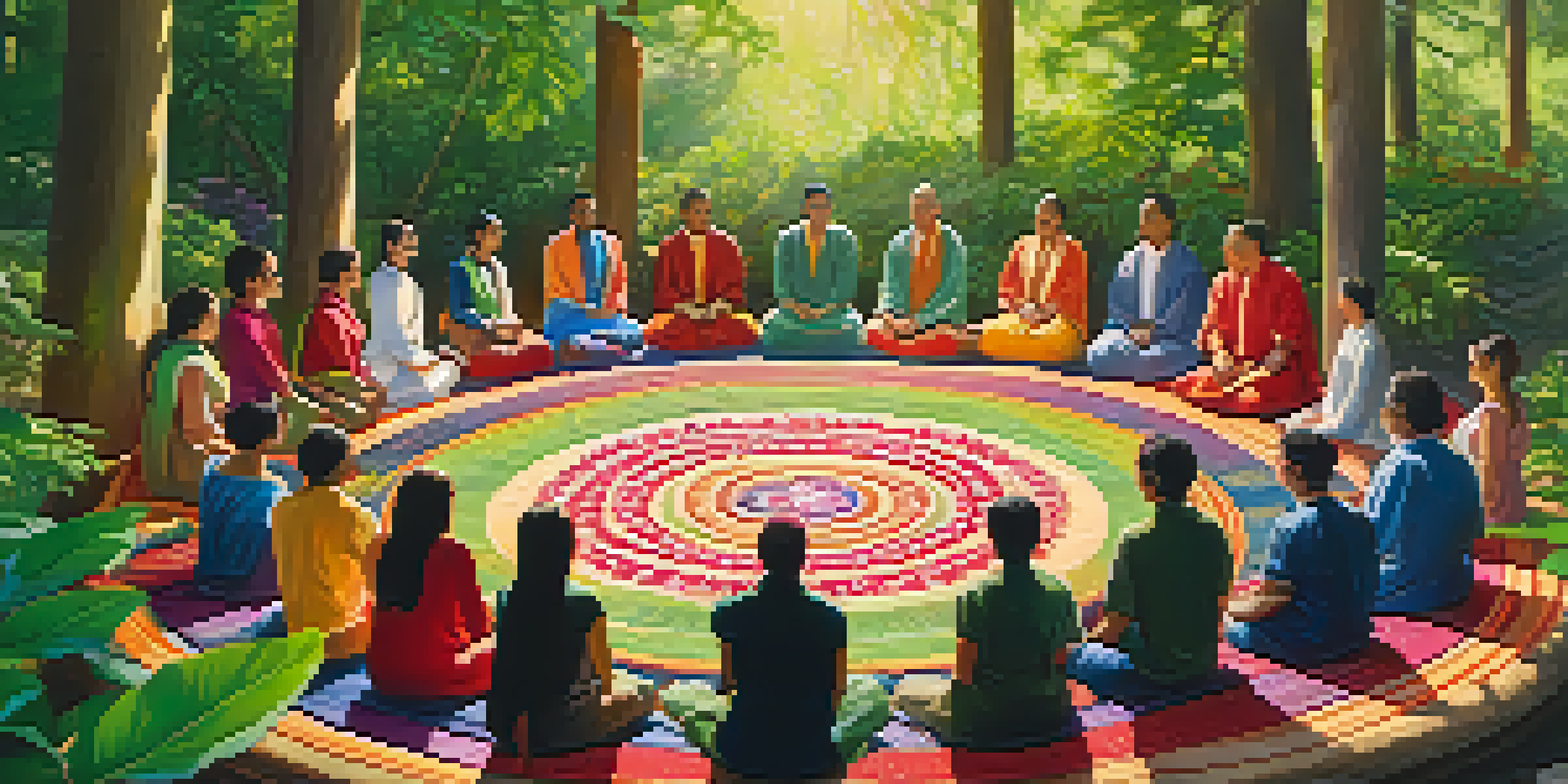Modernization and Its Effects on Entheogen Rituals

Understanding Entheogens and Their Cultural Significance
Entheogens are substances that induce altered states of consciousness, often used in spiritual or religious contexts. They have been integral to various cultures for centuries, providing a means to connect with the divine or explore the self. In many indigenous traditions, these plants or fungi are seen as sacred, facilitating rituals that foster community and personal insight.
Psychedelics can help us understand the nature of consciousness and our place in the universe.
Historically, entheogen rituals have played a crucial role in community bonding and cultural identity. For example, the use of peyote in Native American Church ceremonies exemplifies how these substances foster spiritual experiences that can transcend individual beliefs. Such practices create a shared space for participants to explore their spirituality together.
As societies evolve, the role of entheogens in rituals faces both challenges and transformations. The tension between traditional practices and modern values often leads to a reevaluation of how these substances are perceived and utilized. Consequently, understanding the cultural significance of entheogens is vital for appreciating their evolving role in contemporary spirituality.
The Rise of Modern Spirituality and New Age Practices
In recent decades, there has been a resurgence of interest in spirituality outside traditional religions. This modern spiritual movement often incorporates entheogens, appealing to individuals seeking personal enlightenment and alternative healing. New Age practices frequently blend various traditions, creating a melting pot of beliefs that can sometimes dilute original rituals.

Many contemporary practitioners view entheogens as tools for self-discovery and personal growth rather than solely as sacred substances. This shift highlights a broader trend where individual experience takes precedence over communal traditions. As a result, modern spirituality often emphasizes personal journeys and subjective interpretations of the entheogenic experience.
Cultural Significance of Entheogens
Entheogens have been vital in various cultures for spiritual connection, community bonding, and personal exploration.
While this personalized approach can empower individuals, it also raises questions about cultural appropriation and authenticity. As people adopt these practices without understanding their origins, the risk of misrepresenting or trivializing sacred rituals increases. Hence, balancing modern interpretations with respect for traditional practices is essential.
Impact of Technology on Entheogen Rituals
Technology has dramatically changed the way people access information about entheogens and their uses. Online forums, social media, and documentaries have made it easier for individuals to learn about these substances and their potential benefits. However, this easy access can sometimes lead to misinformation and oversimplification of complex practices.
The greatest gift you can give is your time and attention.
Virtual communities have emerged, offering support for those exploring entheogenic experiences. While this can foster connection and shared experiences, it also risks diluting the depth of traditional rituals. Participating in a ritual through a screen, for instance, often lacks the tangible elements that ground individuals in a shared cultural context.
Moreover, the rise of apps and online guides for psychedelic experiences can commodify what were once deeply spiritual practices. This commercialization can undermine the sacredness of rituals, turning them into mere experiences to be consumed rather than profound journeys of transformation. Thus, the intersection of technology and spirituality presents both opportunities and challenges.
Legalization and Its Influence on Entheogen Use
As society becomes more open to discussing the benefits of entheogens, many regions are exploring legalization. This shift can lead to more regulated and safer use of these substances in therapeutic and spiritual contexts. However, legalization can also change the perception of entheogens from sacred to recreational, altering their traditional roles.
In places where entheogens are decriminalized or legalized, new frameworks for their use are emerging, often prioritizing individual rights and health benefits. This can lead to a more clinical approach, where entheogens are used in therapy sessions rather than communal rituals. While this may enhance accessibility, it risks losing the cultural and spiritual dimensions that have historically defined their use.
Modern Spirituality and Entheogens
The rise of modern spirituality often sees entheogens used as tools for personal growth, sometimes at the expense of their traditional meanings.
The growing acceptance of entheogens in mainstream society also raises ethical questions about commercialization and exploitation. As these substances become more popular, the potential for profit-driven motives may overshadow their cultural significance. Therefore, it’s crucial to navigate this evolving landscape with care, ensuring that traditional practices are respected and preserved.
Cultural Appropriation and Entheogen Practices
Cultural appropriation is a significant concern in the context of entheogen rituals, especially as they gain popularity among non-indigenous groups. When practices rooted in specific cultures are adopted without understanding their significance, it can lead to exploitation and disrespect. This often results in a superficial engagement with practices that hold deep spiritual meaning for their original practitioners.
For instance, the use of ayahuasca in Western wellness retreats is a prime example of this phenomenon. While many participants seek healing and insight, the commodification of this sacred brew can overshadow its cultural roots and the wisdom of indigenous communities. Such practices can inadvertently perpetuate a cycle of appropriation rather than respect and understanding.
Thus, it’s essential for modern practitioners to engage with these traditions thoughtfully and respectfully. This includes educating oneself about the cultural contexts of entheogens and seeking guidance from indigenous leaders. Building genuine relationships with these communities can foster a more authentic understanding and appreciation of their rituals.
The Role of Science in Understanding Entheogens
The scientific exploration of entheogens has gained momentum, leading to a deeper understanding of their effects on the human mind and body. Research into psychedelics has revealed potential therapeutic benefits, including treatment for depression, anxiety, and PTSD. This newfound interest in the science behind entheogens is reshaping public perception and sparking important conversations around their use.
However, as science delves deeper into the mechanisms of entheogens, there is a risk of reducing these substances to mere chemicals. Such an approach can overlook the profound spiritual experiences that many users report. It’s crucial to recognize that while science provides valuable insights, it should not diminish the cultural and experiential aspects of entheogenic practices.
Navigating Cultural Appropriation
It's crucial to approach entheogen practices with respect for their cultural origins to avoid exploitation and superficial engagement.
Balancing scientific research with respect for traditional knowledge creates a more holistic understanding of entheogens. Integrating both perspectives can lead to innovative approaches in therapy and spirituality. Ultimately, acknowledging the complexities of entheogens enriches our understanding of their role in modern society.
Future Directions for Entheogen Rituals in a Modern World
Looking ahead, the future of entheogen rituals will likely be shaped by ongoing dialogues around culture, science, and spirituality. As society continues to evolve, it’s essential to embrace the rich tapestry of traditions while allowing for modern interpretations. Finding ways to honor the past while adapting to contemporary contexts will be crucial for the survival of these practices.
One potential direction is the creation of hybrid rituals that blend traditional elements with modern sensibilities. This could involve incorporating new technologies while still honoring the sacred aspects of the practices. Such innovative approaches can help bridge the gap between generations, fostering intergenerational dialogue and shared experiences.

Ultimately, the future of entheogen rituals will depend on a collective commitment to respect, understanding, and ethical engagement. By prioritizing these values, we can ensure that the transformative power of entheogens continues to inspire and heal in meaningful ways.